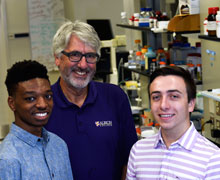Two Albion Students Contribute to Liver Cancer Research
Related Posts
Connect With Us
Jordan Newson, ’17, and Nickolas Kinachtchouk, ’19, were often side-by-side this past summer with Lawrence Schook, ’72, in his University of Illinois lab
September 30, 2016
By Jake Weber

From left: Jordan Newson, ’17, Larry Schook, ’72, and Nickolas Kinachtchouk, ’19, in Schook’s lab at the University of Illinois at Urbana-Champaign. (Photo courtesy UIUC)
Lawrence Schook, ’72, heads a world-class cancer research lab that includes interventional radiologists, oncologists, mouse researchers and a host of other medical professionals. This summer, Schook’s team also included Albion students Nickolas Kinachtchouk, ’19, and Jordan Newson, ’17, who found they could contribute to Schook’s breakthrough approach to a cure for liver cancer.
The collaboration was a definite win-win. Early in 2016, Schook was asked to do a research review, while Kinachtchouk and Newson wanted to develop new skills, gain research experience and increase their attractiveness to graduate schools. Under Schook’s direction, the two students shared primary authorship of a review paper which will be submitted to the journal Digestive Disease Interventions, while Schook got information vital for him and his colleagues.
Looking at reports from institutions around the globe, Kinachtchouk and Newson became close to experts on the problems facing cancer researchers working with laboratory animals. For example, Newson explains that some laboratory animals must undergo immunosuppression in order to grow tumors, a condition that makes immunotherapy research impossible. Also, “laboratory mice and rabbits are just too small,” he says, explaining that researchers struggle with drug dosage and surgical procedures as well as in creating equipment that can be used with these smaller creatures.
In response, Schook and his team are developing a large-animal pig model, the Oncopig, whose anatomy, physiology and pathology are similar to humans and overcome many research obstacles. And while Kinachtchouk and Newson did their literature review on the University of Illinois’ Chicago campus, Schook made sure they regularly visited his lab at the university’s Urbana-Champaign campus to see the work that drew on their research.
“The lab allowed us to understand why we were working on the review paper. When you only work on writing, you can get caught up in the details and forget about the actual purpose of the project,” says Kinachtchouk. “In the lab, we got to examine and feel what a pig liver and what a liver with cirrhosis feels like. This allowed us to directly see the purpose of and better understand our role on the team.”
Kinachtchouk and Newson read hundreds of journal articles, research reports and other materials on hepatocarcinoma, the primary form of liver cancer. “When we began, I had difficulty reading the papers and getting out the important information,” Kinachtchouk says. “We had to learn topics that I hadn’t ever heard of before. Jordan and I also had to work extra hard to understand conversations with the doctors in the lab and the instructions they gave us. ”
“These are two remarkable young students. They did Albion proud,” says Schook, who stepped down as vice president of research for the University of Illinois system in order to return to the lab full time this summer. “Anybody who met them was very impressed, and as an alumnus, that made me very proud.”
Kinachtchouk hopes to eventually become a physician, while Newson is planning to stay in medicine as a researcher. Schook notes that he has invited both to his lab again for next summer.
“I took them to meetings and we met a number of people who asked what year they were in medical school,” Schook recalls. “I got to be where I am because I got these kinds of experiences while a student at Albion. Being exposed to what’s going on outside the classroom is critical.”
Kinachtchouk further reflected that working with Schook was itself a valuable part of the internship. “Wherever he went, we went. It was easy to talk to him and ask questions,” he says. “I truly loved getting to know a great Albion alumnus!”